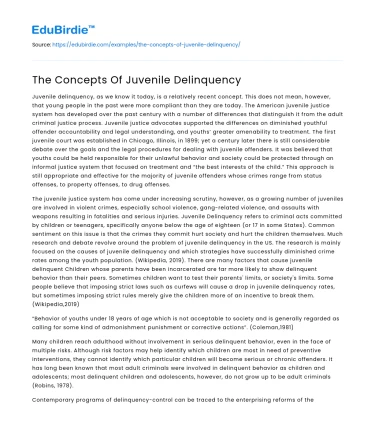Juvenile delinquency, as we know it today, is a relatively recent concept. This does not mean, however, that young people in the past were more compliant than they are today. The American juvenile justice system has developed over the past century with a number of differences that distinguish it from the adult criminal justice process. Juvenile justice advocates supported the differences on diminished youthful offender accountability and legal understanding, and youths’ greater amenability to treatment. The first juvenile court was established in Chicago, Illinois, in 1899; yet a century later there is still considerable debate over the goals and the legal procedures for dealing with juvenile offenders. It was believed that youths could be held responsible for their unlawful behavior and society could be protected through an informal justice system that focused on treatment and “the best interests of the child.” This approach is still appropriate and effective for the majority of juvenile offenders whose crimes range from status offenses, to property offenses, to drug offenses.
The juvenile justice system has come under increasing scrutiny, however, as a growing number of juveniles are involved in violent crimes, especially school violence, gang-related violence, and assaults with weapons resulting in fatalities and serious injuries. Juvenile Delinquency refers to criminal acts committed by children or teenagers, specifically anyone below the age of eighteen (or 17 in some States). Common sentiment on this issue is that the crimes they commit hurt society and hurt the children themselves. Much research and debate revolve around the problem of juvenile delinquency in the US. The research is mainly focused on the causes of juvenile delinquency and which strategies have successfully diminished crime rates among the youth population. (Wikipedia, 2019). There are many factors that cause juvenile delinquent Children whose parents have been incarcerated are far more likely to show delinquent behavior than their peers. Sometimes children want to test their parents' limits, or society's limits. Some people believe that imposing strict laws such as curfews will cause a drop in juvenile delinquency rates, but sometimes imposing strict rules merely give the children more of an incentive to break them. (Wikipedia,2019)
Save your time!
We can take care of your essay
- Proper editing and formatting
- Free revision, title page, and bibliography
- Flexible prices and money-back guarantee
“Behavior of youths under 18 years of age which is not acceptable to society and is generally regarded as calling for some kind of admonishment punishment or corrective actions”. (Coleman,1981)
Many children reach adulthood without involvement in serious delinquent behavior, even in the face of multiple risks. Although risk factors may help identify which children are most in need of preventive interventions, they cannot identify which particular children will become serious or chronic offenders. It has long been known that most adult criminals were involved in delinquent behavior as children and adolescents; most delinquent children and adolescents, however, do not grow up to be adult criminals (Robins, 1978).
Contemporary programs of delinquency-control can be traced to the enterprising reforms of the child-savers who, at the end of the nineteenth century, helped to create special judicial and correctional institutions for the labeling, processing, and management of 'troublesome' youth. Child-saving was a conservative and romantic movement, designed to impose sanctions on conduct unbecoming youth and to disqualify youth from enjoying adult privileges. The child-savers were prohibitionists, in a general sense, who believed in close supervision of adolescents' recreation and leisure. Poor children could become a financial burden, and the child savers believed these children presented a threat to the moral fabric of society. Child-saving organizations influenced state legislatures to enact laws giving courts the power to commit children who were runaways or criminal offenders to specialized institutions. The most prominent of the care facilities developed by child savers was the House of Refuge, which opened in New York in 1825. It was founded on the concept of protecting potential criminal youths by taking them off the streets and reforming them in a family-like environment. (cjcj.org)






 Stuck on your essay?
Stuck on your essay?

